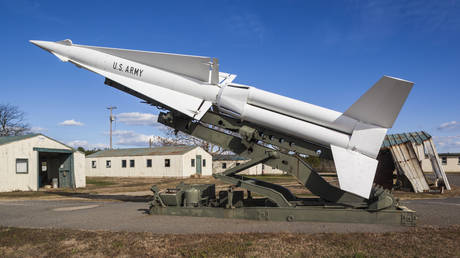ARTICLE AD BOX
Mark T. Kimmitt is a retired U.S. Army brigadier general and has also served as the U.S. assistant secretary of state for political-military affairs.
In May, Israel’s Rafael Advanced Defense Systems acknowledged the use of high-power laser systems in combat. Part of the company’s previously undisclosed Iron Lite program, it’s already credited with intercepting “scores of enemy threats.”
Most crucially, its high effectiveness, far lower cost and scalability, combined with dozens of other counter-drone and defensive programs under development around the world, ends the argument over whether the drone has been a revolution in modern warfare: It has not. And the brief era of drone supremacy has ended.
In 2022, drones became the iconic weapon of the war in Ukraine. Grainy videos showing hundreds of Russian tanks and combat vehicles destroyed by handheld drones grew to be a staple on our screens. Leveraging equal parts battlefield effectiveness, YouTube propagation and morbid entertainment, Ukraine’s media-savvy charismatic president used drone warfare as a way to boost both public morale and international support.
Scores of reports, studies and respected military analysts all suggested this use of drones in Ukraine wasn’t a one-time anomaly, but rather signaled a fundamental change in warfare: Drones are cheap, plentiful and hard to destroy; they end the ability to camouflage rear-echelon troops and command posts; and most importantly, they are unmanned and uncrewed, so the only casualties are targeted adversaries and civilians.
While they seem to be near-perfect weapons, however, drones are no longer invincible.
The battlefield adapts quickly. And like the record of so many other combat disrupters throughout history — cavalry stirrups, Roman phalanxes, longbows, submarines and other supposedly transformative technology that proclaimed to fundamentally change the character of warfare — offensive drones have had a brief window of domination. But it was only a matter of time before effective counter-drone (C-UAS) capabilities emerged.
In the period between the two world wars, for example, airpower theorists promoted the long-range bomber as invincible, even to the point where British Prime Minister Stanley Baldwin proclaimed in 1932 that “there is no power on earth that can protect (us) from being bombed. Whatever people may tell him, the bomber will always get through.” Yet, the rapid development of early radar detection, interceptor aircraft and anti-aircraft guns quickly became effective countermeasures, leaving the long-range bomber a functional role on the battlefield, but it was no longer the “invincible weapon.”
Similarly, there are many reasons why drones no longer dominate today: First, the battlefield is brutal and unforgiving. Just weeks after the appearance of armed drones in Ukraine, Russian units became more skilled at early detection, camouflage, electronic defense and modifying combat vehicles with additional armor to defeat or mitigate incoming kamikaze drones.
 There are many reasons why drones no longer dominate today. | Jose Colon/Anadolu via Getty Images
There are many reasons why drones no longer dominate today. | Jose Colon/Anadolu via Getty ImagesYes, rates of significant drone kills have dropped measurably because of counter-drone technology, but they’ve also done so because of changes in tactics, techniques and procedures.
Next, with urgent demand and increased budgets for new technology significantly escalating, market forces took over. Today, there are few large defense companies that don’t have a C-UAS system under development, and the diversity of solutions is breathtaking. To that end, the further development and use of overlapping technologies to detect and defend units are significantly increasing the probability of defeating drone attacks.
Most pressingly, drone-on-drone combat enabled by artificial intelligence is currently within reach. Swarm attacks from both enemy UAS and missiles can overwhelm many, if not all, manually controlled defenses. Humans are simply unable to process dozens of targets simultaneously, and the relatively limited number of defense systems that can handle multiple targets are prohibitively expensive.
As we saw with the attacks from the Houthis, Hezbollah and Iran in the ongoing Israeli conflict, Israel’s and Ukraine’s defenders have been hard-pressed to address all incoming attacks, and the costs have been staggering — which means cheap counter-drones, produced at scale, enabled by AI are the most promising technology to defeat an offensive drone threat.
In many ways, AI-enabled UAS could mimic air force tactics developed soon after the invention of the combat aircraft. There would be intelligence gathering, attack and bomber drones for the forward battlefield, interceptors to warn of inbound attacks and fighter variants for aerial combat. Thus, AI-enabled drones will undoubtedly be a potent 21st century air force, augmenting, if not replacing, a human in the cockpit — a capability that’s dangerously inexpensive and no longer exclusive to nation states.
This is not to say that UAS are already obsolete. The use of drones in Iran were impressive but relied more on surprise than on a revolutionary technology. And recent attacks in Ukraine have relied on mass rather than invincibility, demonstrating Joseph Stalin’s dictum that “quantity has a quality all its own.” But they just have not — as some breathless analysts proclaim — changed the fundamental character of modern warfare, and one can expect swarms of AI-enabled drones augmented by ground-based lasers can provide an effective and low-cost method to defeat swarms of incoming drones.
General George Patton once declared that victory in combat is achieved by the “Musicians of Mars” — the commanders who understand how to properly employ all the weapons of war. Drones are on today’s battlefield, and they have a significant role in combat now, as they will for the foreseeable future.
They were the most important weapon for the outnumbered Ukrainian army to blunt Russia’s Vladimir Putin’s massive armored attack in 2022, destroying a staggering number of Russian tanks and combat vehicles. Without those drones, we may have been faced with completely different state of play today.
Of course, drones still play a critical role in maintaining the near stalemate in Ukraine, and they will have a role on the battlefield for years to come. But like so many other wonder weapons once thought revolutionary and invincible, drone supremacy has already had its moment on the modern battlefield.
.png)
 7 hours ago
2
7 hours ago
2








 English (US)
English (US)